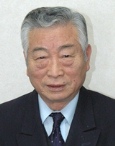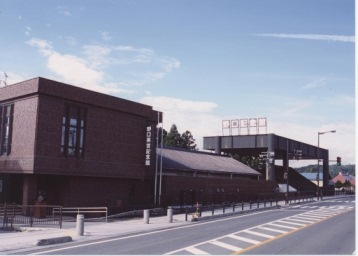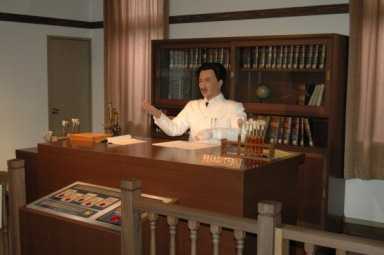What the Doctor Has Taught Us: Footsteps of the Doctor and His Friends - Yasuo Yago, Director of Hideyo Noguchi Memorial Hall
|
|
|
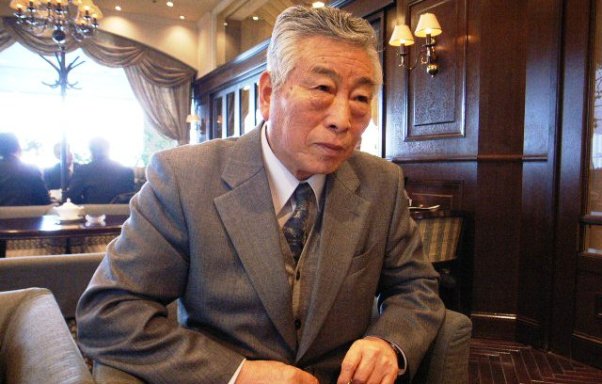
Yasuhei Yago liked the doctor more than anyone else:
The friendship between Yasuhei and Dr. Noguchi
Your grandfather was Mr. Yasuhei Yago, who was Dr. Noguchi’s friend. What is the most impressive story about Dr. Noguchi that your family has told you?
Mr. Yago: There are so many that it is difficult to pick one. For example, this is a photograph of the doctor and my grandfather. It was taken in Aizuwakamatsu when my grandfather went to pick up the doctor from Kaiyo Hospital on the day he was discharged after an operation. It was the very first photograph taken of the doctor, and no earlier photographs have been discovered to date. It was about 26 km from Sanjo Gata, where the doctor lived, to Kaiyo Hospital, and grandfather had to go to and from the hospital on foot. You can tell from the photograph that the doctor, being thoughtful, let my grandfather sit down.
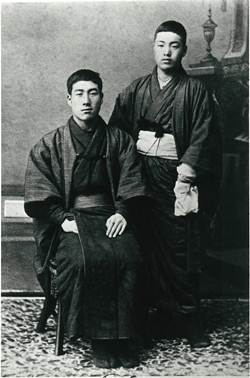
This was in 1884, after the operation on his left hand, the doctor and his friend, Mr. Yasuhei Yago (on the left). This photograph was the first taken of Dr. Noguchi. The doctor showed excellent performance in school and was considered to have a promising future, and at the age of 16 he underwent a surgical operation on his left hand, which had been accidentally burned when he was one year old. He was supported by his school teacher and friends. The doctor was very much impressed by this operation, and it triggered his aspiration to become a medical doctor.
(Photograph provided by the Hideyo Noguchi Memorial Association)
Dr. Noguchi set out for the United States in 1900 with the support of many people, including the Yago family, his former teacher Mr. Sakae Kobayashi (*who discovered Dr. Noguchi's talent in elementary school), and Dr. Morinosuke Chiwaki (* founder of Takayama Dental School [which later became Tokyo Dental College]; supported Dr. Noguchi throughout his lifetime ever since he took the National Medical Practitioners Qualifying Examination). The doctor later played an active role around the world. Why did Dr. Noguchi captivate so many people?
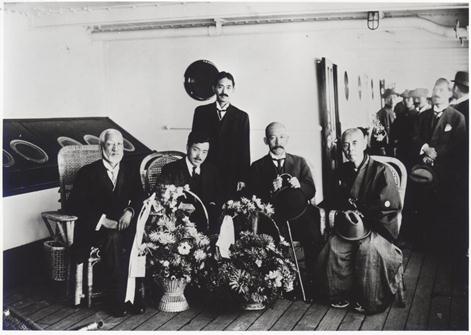
In 1915, Dr. Noguchi returned to Japan after 15 years of absence. This is a photograph taken on the deck of the Sadomaru with his teachers when he was about to go back to the United States. From left to right, Dr. Kanae Watanabe, Dr. Noguchi, Dr. Saburo Ishizuka, Dr. Morinosuke Chiwaki, and Mr. Sakae Kobayashi.
(Photograph provided by Hideyo Noguchi Memorial Association)
Mr. Yago: I’ve heard that the doctor was exceptionally smart. Once he looked up a word in a dictionary, he would instantly remember that word and never have to look it up again.
Also, when he returned to Japan in 1915 for the first time in 15 years, he did calligraphy with a brush if requested. He wrote almost 100 calligraphic works, swiftly writing a word that suited the person who requested the work. Grandfather received three of such works from the doctor, with the words saisei (saving lives), datsujin (climbing out of the dust of this world), and kaikyu (reminiscing about old times), but grandfather donated two of them to a temple, keeping only kaikyu. Family members suggested that he should keep all of them at home as the doctor had written them especially for him, but he donated the two to the Yago family’s temple (Saienji Temple), insisting that they should be made available for many people to see. They are still displayed in the main hall of Saienji Temple.
Grandfather liked the doctor more than anyone else. He could not wait to see how the doctor’s talent would grow and how and would accomplish what grandfather could not do himself. It was the Meiji era when various western civilization came into Japan, so I think there was a pioneering spirit among people, too.
For the doctor, the world was small. He was very smart and could always anticipate the future. The doctor felt that if he stayed in Japan his turn to go to the United States would never come, so he raised money himself and ventured to the United States. I think he really had the ability to foresee the future.
The most attractive of Dr. Noguchi’s traits were his talent and captivating veracity—“veracity” both in a good and bad sense. No ordinary person could ask an old teacher for money. Until the doctor's portrait was printed on the thousand yen bank note* and I began to get interviewed, I did not talk much about the link between the Yago family and the doctor to other people. It was because of my grandfather's teaching. My father and I had abided by his teaching that "our commitment to the doctor may not be something that the doctor can be proud of, so do not mention it to others." Therefore, we had not talked about it so much before, but actually Dr. Chiwaki, Mr. Kobayashi, and all the others competed with each other to support the doctor, insisting, "I'm the one who is supporting him the most!" I came to get more chances to talk in interviews related to the one thousand yen note, and was advised by my sister not to get carried away and talk about things our parents haven't even talked about in public. Some biographies seem to mistakenly suggest that people supported the doctor after being taken in by his smooth talking, but that is not true.
For the Yago family, the doctor is like one of our relatives. When we say "the doctor," it means Dr. Hideyo Noguchi, and we do not even say "Dr. Noguchi." It is about 6 km from Sanjo Gata, where the Noguchi family lived, to Inawashiro Town, where the higher elementary school was, and the doctor seems to have occasionally stayed at our house overnight, for example, when there was a blizzard in winter. I heard in person from a lady who had served as our housekeeper that she always had the desire to get a glimpse of the doctor's left hand some time. When the doctor stayed overnight, she tried to get a chance to take a peek when she was bringing a meal to his room, but grandfather Yasuhei always told her to leave the meal outside the door; she never opened the door to the room, so she never got a chance to directly see the doctor's burned hand.
The doctor's old teacher, Dr. Chiwaki, overlooked his misbehavior. He even overlooked conduct that he would have scolded other pupils for. This was because he had perceived the doctor to have special potential to develop. He knew that the doctor would become a person of character once he grew out of the cheeky age. Indeed, you can see from the letters that remain that, after going to the United States, the doctor's personality had become more and more refined every year. You can see that he became a gentleman in a few years after moving to the United States. I think it was also lucky for him to have encountered people of distinguished character, such as Dr. Flexner at the Rockefeller Institute, and Dr. Madsen at Statens Serum Institut in Denmark. Dr. Chiwaki and Mr. Kobayashi must have detected that from early times. Though I think grandfather supported the doctor only because he liked him so much!
* Dr. Noguchi's portrait has been used on the thousand yen bank note since 2004. It was the first time a scientist's portrait was used on a Japanese bank note.
- Engaged in research without concern for his own life -
Dr. Noguchi dedicated himself to study in Africa so much that he extended his initially-planned three-month stay to six months and even lost his life in the midst of research on yellow fever in Ghana. What drew Dr. Noguchi so strongly to Africa?
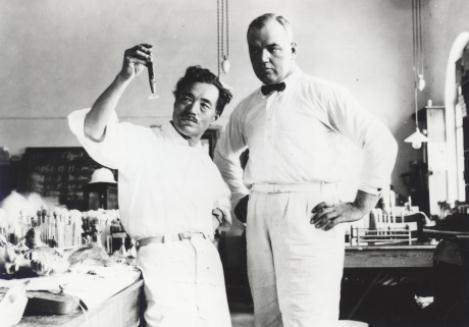
Dr. Noguchi and Dr. Mahaffey researching in Africa. Studying infectious diseases in Africa was extremely dangerous at the time. Many researchers lost their lives to infectious diseases during their research. When Dr. Noguchi decided to go to Africa, people around him opposed him from concern about his safety, but he set off in 1927, determined to clarify the cause of yellow fever, which was prevailing around the world.
(Photograph provided by the Hideyo Noguchi Memorial Association)
Mr. Yago: There were many reasons. One was the death of his colleague Dr. Stokes (*a colleague at the Rockefeller Institute who caught yellow fever and lost his life during research in Africa). Another reason was that doctor placed emphasis on field activity. At that time, other researchers adopted the stance of just collecting samples and studying back at home, but the doctor wanted to do research and clarify the cause of the disease at the actual site. We can see from his letters that he had no concern for his own life. He always wholly engaged in research in that way. It is most regrettable that there was no electron microscope at the time. The doctor had ascertained that some kind of filterable organism was involved, but however hard he observed, he could not see the virus using the instruments available at that time. Electron microscopes were developed more than ten years after his death.
- What we can learn from Dr. Noguchi at a time like this -
The Great East Japan Earthquake in March 2011 greatly affected Fukushima Prefecture, the homeland of Dr. Noguchi. The Hideyo Noguchi Memorial Hall in Inawashiro Town escaped damage, but please tell us the current situation surrounding the Memorial Hall and Fukushima Prefecture, and what you think are the things that must be done at a time like this.
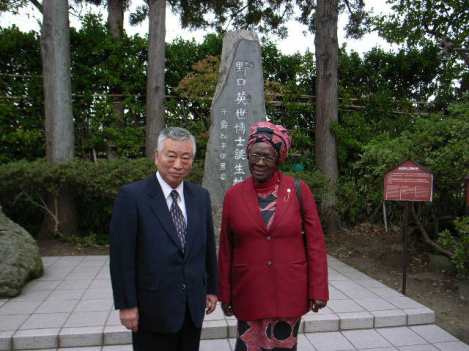
October 5, 2011. Dr. Miriam K. Were, the first winner of the Hideyo Noguchi Africa Prize visiting the Hideyo Noguchi Memorial Hall after the earthquake disaster, with Mr. Yago. After participating in an STS Forum in Kyoto, Dr. Were visited Fukushima Prefecture, the place of memories of the first prize-giving ceremony, and encouraged people there.
Mr. Yago: In fact, the nuclear power plant accident has had a greater impact than the earthquake. In particular, tourism has received a devastating blow. The number of visitors to the Memorial Hall has dropped sharply. We want as many people as possible to come to the Hideyo Noguchi Memorial Hall and learn about the doctor. That is our mission. The doctor always strove to pursue his objectives under adverse circumstances. Like him, we should not give in to the current difficult conditions. The Hideyo Noguchi Memorial Hall is about 85 km away from the nuclear power plants, and the radiation dose has been about 0.15 microsieverts/hour since the time of the accident, and has never risen any higher. It is a pity that some people misunderstand the actual circumstances and avoid visiting Fukushima Prefecture. As for school trips, teachers may agree to the visit, but they face opposition from students' parents. Immediately after the accident, it was difficult for the staff to even reach the Memorial Hall due to a lack of gasoline. It will surely take time to recover to the original state.
As a memorial hall for an individual person, the Hideyo Noguchi Memorial Hall originally boasted one of the largest numbers of visitors in Japan. The activities of the Hideyo Noguchi Memorial Association are financed by the hall's admission fees without being assisted by any other organization. The Hideyo Noguchi Memorial Medical Award and the Hideyo Noguchi Memorial Association Scholarship System are also totally funded by the admission fees.
The Hideyo Noguchi Memorial Hall has the house where the doctor was born on its premises, right in its original spot. We take pride in the fact that we have not moved it an inch.
If we could, we would expand the exhibition space to double the current size. More than half of the materials we have are back in the storeroom, and they are exhibited in turns. In particular, there is an enormous number of letters. Many letters remain, since Mr. Sakae Kobayashi had told the doctor, "Write to me about how you are doing if you find any time. I will serve as the contact point and have others read those letters." Thanks to those letters, we can still learn what the doctor was doing. When I have a chance to talk about the doctor at a place I visit for the first time, I use his letters. We can find out about the path he tread by reading biographies, but if we read his letters, we can learn what kind of ideas he had and what kind of personality he had. Their contents are educational both for adults and children.
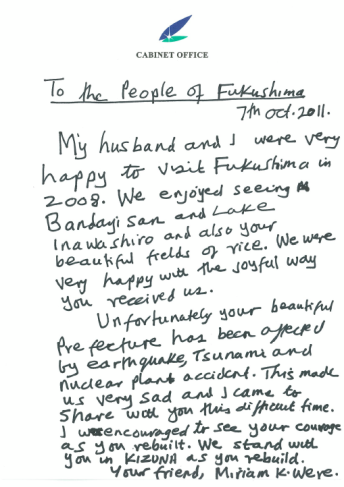
This is Dr. Were's handwritten message to people in Fukushima Prefecture. It incorporates her thoughts that "we will be with you together under KIZUNA as you engage in reconstruction."
Which one is your favorite letter?
Mr. Yago: Again, it is very difficult to choose, but my favorite letter is probably the one that reads, "What I keep in mind in my daily life is to place becoming a good person first, and learning second." The doctor, who was smarter than anybody else, said it is more important to become a good person than pursue learning. It may sound pedantic if we say it, but it carries weight when the doctor, who was actually smart, says it.
I think the reasons that the doctor could keep pursuing his objectives under difficult circumstances were the fact that he could not use his left hand freely, he wanted to make his parents feel relieved, and he wanted to repay the people who supported him. It may have been good that the doctor did not enjoy perfect circumstances, but rather depended on people and received their support. We can see from his letters that his homeland was always in his mind, and he loved his home country while living in a foreign country.
Dr. Saburo Ishizuka (*a dentist who spent time with the doctor at Takayama Dental School [which later became Tokyo Dental College]), Mr. Hajime Hoshi (*a supporter of the doctor and the founder of Hoshi University), Mr. Ichiro Hori (photographer and painter who lived in the same apartment as the doctor in New York and supported him) and other people with whom the doctor had a close relationship at some point remained his lifelong friend. These people were charmed by and attracted to the doctor's personality, and their relationships were not merely superficial.
Woodlawn Cemetery is a special cemetery, and the only Japanese people buried there are the doctor and another scientist, Dr. Jokichi Takamine. The Rockefeller Institute had treated the doctor that well. After the doctor died, the Rockefeller Institute provided a pension to his wife, Mary, and took care of her until her death. Mary is said to have sent money to the doctor's parents from that pension. The Institute considered the doctor to be that important. I think it was destiny for the doctor to have been taken care of by such an institute. A Japanese research institute would not have been able to look after researchers that well. In 1997, when I visited the Woodlawn Cemetery for the first time, the place where neither my grandfather nor my father could go, my legs trembled. I would very much like to visit there once again, but I haven't been able to realize this wish.
While hearing stories about him, I'm beginning to feel that I want to meet the doctor in person.
Mr. Yago: You are right. What would the doctor have thought if he saw the present Japan? I'm sure he would have provided us some guidelines.
Mr. Yago, do you have any message you would like to convey?
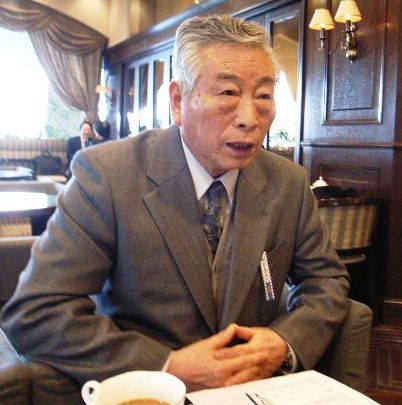
Mr. Yago: I want as many people as possible to know about the doctor. In particular, I want children to learn about how he lived. Therefore, I want to get the Memorial Hall back to its normal state as early as possible and have many people visit the hall. I want to carry out activities not only within the hall, but also in places outside the hall. Every month, the number of visitors is gradually recovering. At present, the number of visitors we have is 40 to 45% of that in normal times, but we want to raise the percentage to 70 to 80% next fiscal year.
Besides research, the doctor had an outstanding talent in languages. Although the doctor himself said that there is no natural-born genius, and that genius results from efforts, he was a genius . Hardly anyone is as talented as he was.
A long letter the doctor wrote to my grandfather before heading to the United States, which is still kept by the Yago family, says, "I know I'm talking big, but don't lump me in with elite graduates of the University of Tokyo." Since grandfather was his friend, the doctor was writing his thoughts honestly. He had confidence in himself. He had also written Chinese-style poems in that letter. They went mate onore, sakade chirinaba, naniga ume (Hey myself! Would you really be living if you did not achieve success?) and tsumore yuki, iwa no shimizu no koru made (Snow! Pile up until the water trickling out of rocks freezes). I'm sure he was expressing a cold and empty feeling. The doctor could easily come up with such impressive phrases.
Also, the doctor was honest and frank. When he returned to Japan for the first time in 15 years, he wrote, "Objectives, honesty, and patience," on a blackboard at Okinashima Elementary School in Inawashiro, and rubbed it out when he moved on to another topic. However, a teacher wrote down those words, copying the doctor's handwriting from the remaining traces, and now they are cited as the educational policy of elementary schools in Inawashiro.
When he was back in Japan, he was much sought after, running a schedule worked out to the minute. Various universities invited him. I'm sure he said many impressive phrases. It is a pity there were no audio tapes. There are no recordings of the doctor's voice. Also, because he died from yellow fever, his remains are buried in New York under a promise that the coffin would never be opened.
I’ve heard that, when he was back in Japan, he took his mother on a trip to the Kansai region, and when they stopped by at a traditional Japanese restaurant in Osaka, geisha there wept upon being moved by his devotion to his mother and could not dance properly.
I would lose to the doctor in all respects but one. That is, I was able to stay near my parents and do good by them. I beat him there! A person of merit inevitably entails some sacrifice. I am sure, deep inside, that both the doctor himself and his mother, Shika, wanted to stay together.
Information - Hideyo Noguchi Memorial Hall
|
|
|
(Photograph provided by the Hideyo Noguchi Memorial Association)
Hideyo Noguchi Memorial Hall introduces to visitors the life and achievements of Dr. Hideyo Noguchi, a bacteriologist who engaged in worldwide activity, through many of his belongings, letters, and photographs.
The house where Dr. Noguchi was born remains in its original place in its original form, and visitors can see the fireplace in which the doctor burned his hand at the age of one and half, and the alcove post where he inscribed his determination when leaving for Tokyo.
A very realistic Dr. Noguchi robot welcomes visitors with gestures, and gives them a message that will cheer them up.
Please come to the Hideyo Noguchi Memorial Hall, the place where Dr. Noguchi was born. It is abundant with nature, with Mt. Bandai towering in the north and Lake Inawashiro stretching to the south. I am looking forward to your visit.
Access from the Tokyo region
By carTake the Tohoku Expressway, change to the Ban-etsu Expressway at the Koriyama Junction, and exit at Inawashiro Bandai Kogen Interchange. From there it is about seven minutes drive on Route 49.
By train
Take the Tohoku Shinkansen, change to the JR Ban-etsu West Line (outbound) at Koriyama Station, and get off at Inawashiro Station. From there it is about 10 minutes by bus or taxi.

